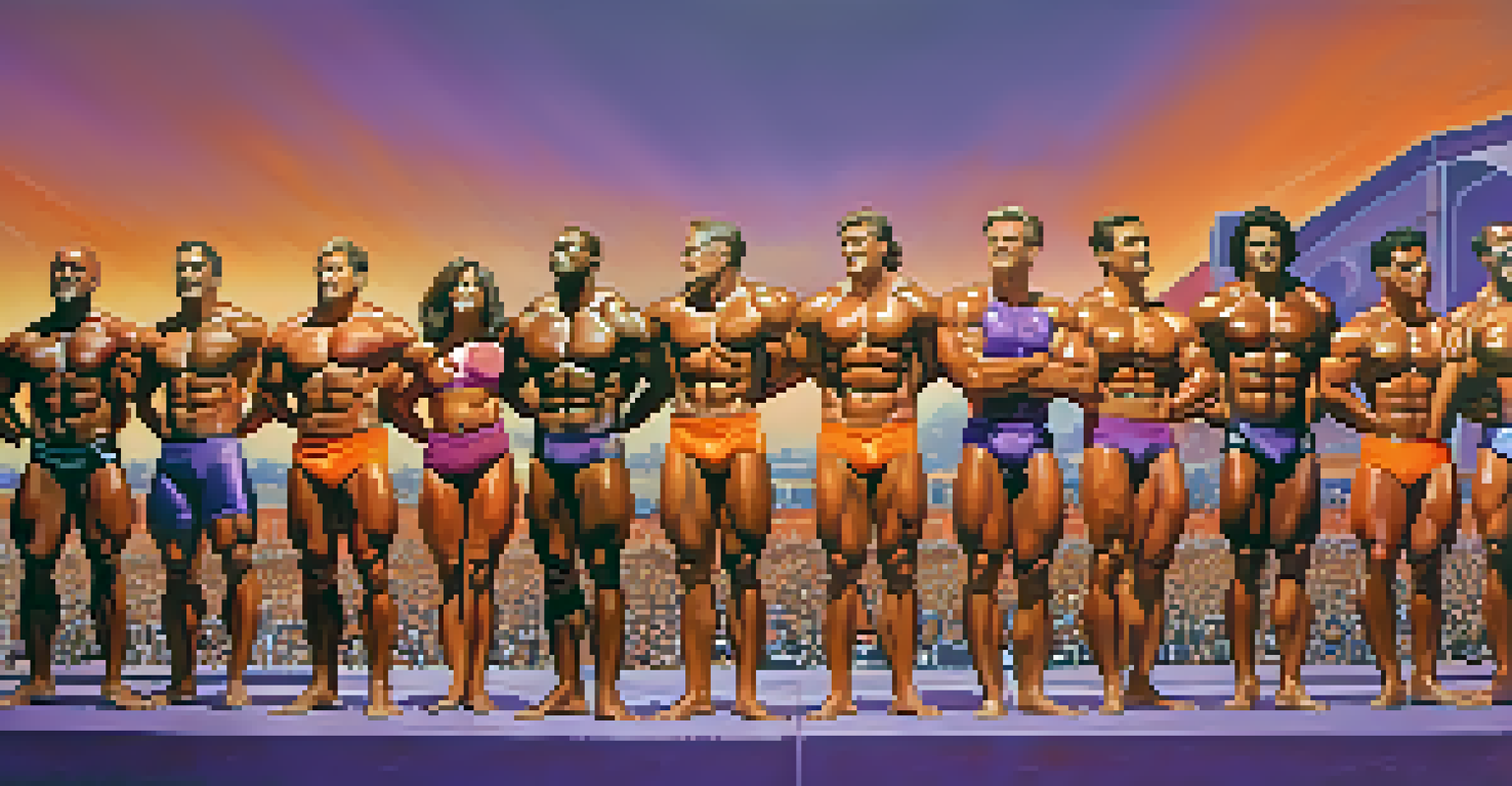Bodybuilding and the Rise of Physical Culture Movements

The Origins of Bodybuilding: A Historical Overview
Bodybuilding has roots that stretch back to ancient civilizations, where physical strength was celebrated in various cultures. From the Greeks and their admiration for the human form in art to the gladiators of Rome, the pursuit of strength has always been part of human history. Fast forward to the late 19th century, and we see the emergence of modern bodybuilding with figures like Eugen Sandow, who popularized the sport through performances and competitions.
Strength does not come from physical capacity. It comes from an indomitable will.
The rise of physical culture movements in the late 1800s and early 1900s marked a significant shift towards valuing fitness and aesthetics. These movements emphasized the importance of exercise, diet, and lifestyle in achieving physical excellence. As more people began to embrace these ideals, bodybuilding evolved into a competitive sport, with the first Mr. Olympia contest taking place in 1965, showcasing incredible physiques and inspiring many to take up the practice.
Today, bodybuilding is not just a sport but a global phenomenon, influencing fitness trends and lifestyles. With the rise of social media, aspiring bodybuilders can now share their journeys and connect with others, fostering a sense of community that continues to grow. The history of bodybuilding is a testament to humanity's enduring fascination with strength and self-improvement.
The Influence of Physical Culture on Bodybuilding
Physical culture movements have played a pivotal role in shaping modern bodybuilding. These movements advocated for the benefits of exercise and healthy living, challenging the sedentary lifestyle that was becoming prevalent during the industrial revolution. As a result, many people began to recognize the importance of physical fitness, paving the way for bodybuilding to flourish.

One of the key elements of physical culture was the promotion of a balanced lifestyle, which included not just strength training but also proper nutrition. This holistic approach resonated with many, leading to the development of various diets tailored for athletes and bodybuilders alike. The emphasis on nutrition helped to elevate bodybuilding from mere lifting weights to a well-rounded discipline focused on achieving optimal performance and aesthetics.
Bodybuilding's Rich Historical Roots
Bodybuilding has evolved from ancient civilizations celebrating strength to a modern global phenomenon, shaped by cultural movements and influential figures.
Furthermore, the physical culture movement laid the groundwork for the bodybuilding community that exists today. As enthusiasts gathered to share their experiences and knowledge, they created a culture centered around camaraderie, support, and competition. This sense of belonging continues to drive the passion for bodybuilding, making it more than just a sport—it's a lifestyle.
The Role of Women in Bodybuilding's Evolution
While bodybuilding has often been male-dominated, women have played a crucial role in its evolution. In the early days, female bodybuilders faced significant societal challenges, as traditional views often discouraged women from pursuing strength training. However, pioneers like Lisa Lyon and Rachel McLish broke barriers in the 1980s, proving that women could be strong and muscular while still embracing femininity.
The difference between a successful person and others is not a lack of strength, not a lack of knowledge, but rather a lack in will.
Their success not only inspired a new generation of female athletes but also contributed to the growing acceptance of women in the sport. As more women entered the bodybuilding scene, competitions dedicated to female bodybuilders began to emerge, such as the Ms. Olympia contest. This shift allowed women to showcase their hard work and dedication, further legitimizing their role in the sport.
Today, female bodybuilders are celebrated for their strength, discipline, and achievements, shattering stereotypes and inspiring others. The rise of social media has also amplified their voices, allowing them to share their journeys and connect with a wider audience. As a result, women have become an integral part of the bodybuilding community, influencing its future direction and growth.
The Impact of Technology on Bodybuilding
In recent years, technology has dramatically transformed the world of bodybuilding. From advanced training equipment to fitness apps and online coaching, athletes now have access to tools that were unimaginable just a few decades ago. These innovations have made it easier for bodybuilders to track their progress, optimize their workouts, and achieve their goals more efficiently.
Moreover, social media platforms like Instagram and YouTube have revolutionized the way bodybuilders share their experiences and connect with others. Athletes can now showcase their training routines, diet plans, and competition prep, allowing them to inspire and motivate others in the community. This visibility has also helped to break down barriers, making bodybuilding more accessible and inclusive.
Women Pioneering Bodybuilding
Female bodybuilders have significantly contributed to the sport's evolution, breaking societal barriers and fostering an inclusive community.
However, it's essential to remember that while technology can enhance performance, it shouldn't replace the fundamental principles of bodybuilding, such as hard work, discipline, and dedication. Striking the right balance between leveraging technology and maintaining a strong foundation is key to success in this evolving landscape. As technology continues to advance, the future of bodybuilding looks promising, with new opportunities for growth and development.
Bodybuilding and Mental Health: A Powerful Connection
The relationship between bodybuilding and mental health is a topic that deserves attention. Many individuals turn to bodybuilding not just for physical transformation but also for mental well-being. The discipline involved in training and nutrition can create a sense of purpose and accomplishment, which is beneficial for overall mental health.
Engaging in regular exercise, including bodybuilding, has been shown to reduce symptoms of anxiety and depression. The endorphins released during workouts contribute to improved mood and emotional stability. Additionally, the structured nature of bodybuilding allows individuals to set and achieve personal goals, fostering a sense of control and empowerment in their lives.
Moreover, the bodybuilding community provides a support system that can be invaluable for mental health. Sharing struggles and celebrating victories with fellow enthusiasts creates bonds that can help individuals feel less isolated. As more people recognize the mental health benefits of bodybuilding, it continues to grow as a powerful tool for self-improvement and resilience.
The Future of Bodybuilding: Trends and Innovations
As we look to the future, bodybuilding is poised for exciting developments. One significant trend is the growing emphasis on health and wellness over aesthetics. Many aspiring bodybuilders are now prioritizing functional fitness and overall well-being, rather than just striving for a particular physique. This shift reflects a broader societal change towards valuing health and longevity.
Additionally, advancements in nutrition science and supplementation continue to shape the bodybuilding landscape. Athletes now have access to a wealth of information and products designed to enhance performance and recovery. From plant-based proteins to cutting-edge recovery technologies, these innovations further support bodybuilders in achieving their goals while maintaining their health.
Tech's Role in Bodybuilding Growth
Advancements in technology and social media have transformed bodybuilding, enhancing accessibility and community engagement while promoting overall well-being.
Lastly, inclusivity and diversity are becoming increasingly important in the bodybuilding community. Organizations are making efforts to promote equal opportunities for athletes of all backgrounds, ensuring that everyone can participate and thrive in the sport. As bodybuilding evolves, it will undoubtedly continue to adapt and grow, embracing new ideas and perspectives that reflect the changing world.
The Cultural Significance of Bodybuilding Today
Bodybuilding has transcended its origins to become a significant cultural phenomenon. It represents not just physical strength but also the values of dedication, hard work, and perseverance. This cultural significance is evident in the way bodybuilding is portrayed in media, from films to documentaries, which often highlight the transformative journeys of athletes.
Moreover, bodybuilding has influenced fashion and lifestyle trends, inspiring individuals to adopt healthier habits and prioritize fitness. The rise of fitness influencers and athletes on social media platforms has further fueled this cultural movement, encouraging more people to engage in strength training and embrace body positivity.

As bodybuilding continues to evolve, its impact on culture will likely persist, shaping societal attitudes towards fitness and health. The celebration of strength and aesthetics will remain central to its identity, while also fostering a more inclusive and diverse community. In this way, bodybuilding not only promotes physical fitness but also serves as a powerful reminder of human potential and resilience.